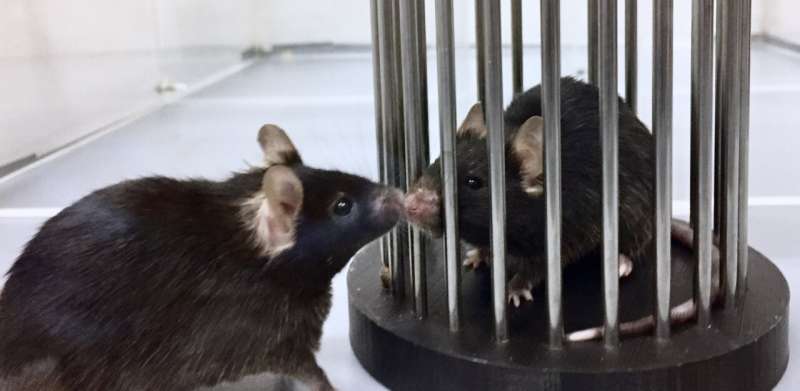
Social interactions are regulated by the neuronal circuits underlying motivated behaviors. These reward circuits involve the brain’s ventral tegmental area and its dopaminergic neurons. However, which brain areas convey information about social interaction to the ventral tegmental area is still rarely investigated. After studying interactions between male mice, a team from UNIGE and the National Centre of Competence in Research Synapsy has succeeded in identifying two distinct neural pathways to the Ventral Tegmental Area.
The first originates in the superior colliculus and manifests enhanced neuronal activity when the mice orient their attention towards the unknown conspecific. The second originates in the medial prefrontal cortex and is activated following the first contact between the two rodents. The two pathways are important for initiating and maintaining the interaction. The results of this research, published in the journal Nature Communications, show that two distinct sub-circuits control different aspects of social behavior. This is a discovery of great interest for understanding mental disorders involving social deficits, including autism.
Interactions between two individuals who do not know each other—regardless of whether the interactions are aggressive, peaceful or constructive—follow a number of steps. The first consists quite simply of spotting the other individual and turning towards him or her. Contact is then sought, resulting in an ongoing social interaction. These steps, which depend on the reward system that originates in the ventral tegmental area (VTA) of the brain, involve dopaminergic neurons, widely recognized as the brain’s “social” neurons. It was thought that mental disorders characterized by social interaction problems, such as autism spectrum disorders, might involve a dysfunction in these neural systems. To gain a deeper understanding, the team led by Camilla Bellone —professor of neurosciences at the University of Geneva (UNIGE)— conducted a study to define the neural pathways entering and leaving the VTA during the different stages of social interaction.
Study supported by clinical work
“Our discussions with clinical researchers from the Synapsy National Centre of Competence in Research helped us start the study, which was carried out on mice, based on concrete facts observed in humans,” begins Professor Bellone. “The work done by Marie Schaer, a researcher at UNIGE, shows that people with autistic traits can’t orient towards others.”
This means that one of the three steps required for social interaction is missing. “Could it be because the dopaminergic neurons in the ventral tegmental area do not receive the information correctly?” asks Clément Solie, co-author of the study and a postdoctoral fellow at the University of Geneva at the outset of the research. However, before finding out more about the cerebral dysfunctions, it was necessary to understand the basic mechanisms or to be more precise: what neural pathways are involved?
Two distinct pathways
The research team set out to determine which neurons were connected to the VTA and were active during social interaction using mice. “First, we placed a mouse in an arena, measuring its brain activity and giving it the option only to look left or right when a second mouse was introduced,” explains Alessandro Contestabile, a Ph.D. student at UNIGE and co-author of the study. In the first instance, the researchers identified a multi-sensory neural pathway known to be involved in vision and hearing but whose involvement in social behaviors was previously unknown. “Originating in the superior colliculus its neurons fired when the mouse positioned itself to look for the other mouse,” continues Alessandro. Next, when the researchers interfered with these neurons, they were able to prevent the mouse from positioning itself and, it follows, from initiating the interaction.
Honing their analysis, the neuroscientists subsequently placed the mice into an arena to favor interaction among conspecifics without restricting their movement, and their initial observations were confirmed. “This means there is a dopaminergic neural pathway, previously unknown in this context, that is important for moving towards the other during social interaction,” says Professor Bellone.
An application for autism?
Source: Read Full Article
